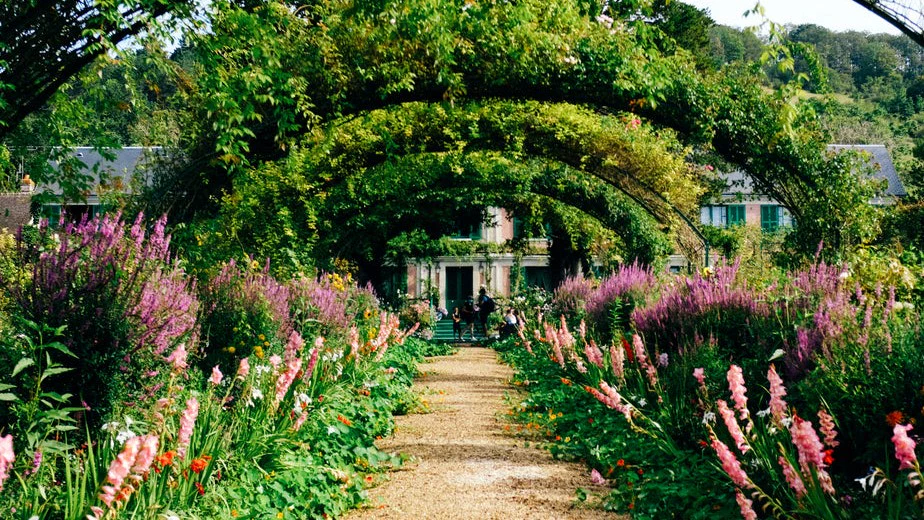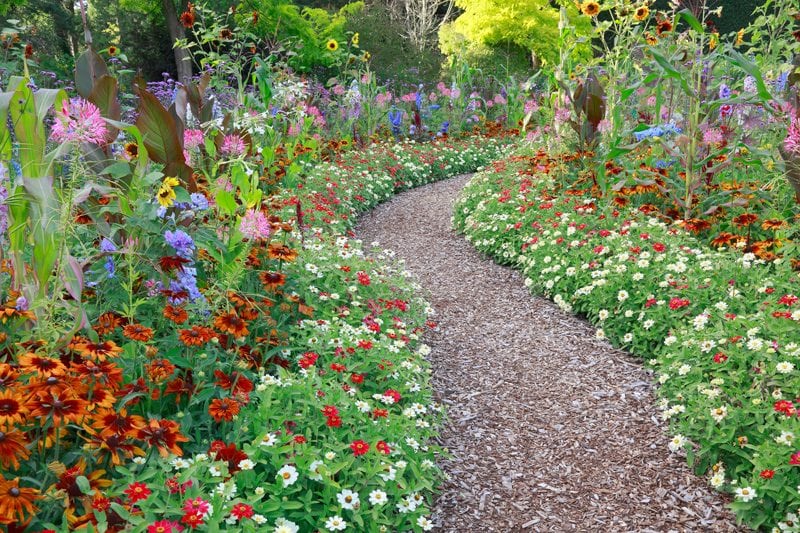Want your garden to tell a story and serve a purpose? That’s what thematic gardening is all about. You design your garden around a single idea or goal. It could be a pollinator garden, rain garden, food forest, sensory garden, xeriscape, or even a vertical garden for compact balconies.
These themed approaches make garden planning easier and more meaningful. They can also solve common challenges in Indian homes such as extreme heat, water scarcity, lack of space, and the need for year-round greenery.
Below, you will find detailed ideas, plant suggestions, and tips tailored for Indian conditions.
Why Choose a Garden Theme?
- Gives your garden a clear direction
- Helps you select the right plants
- Reduces wastage of water and resources
- Saves time and maintenance effort
- Creates an attractive and purposeful space

1) Pollinator & Butterfly Garden
Goal: Attract bees, butterflies, and beneficial insects to your garden.
Why it’s important: Pollinators are essential for food crops and urban biodiversity.
Key steps:
- Plant nectar-rich flowers in clusters.
- Ensure blooms in all seasons.
- Avoid chemical pesticides.
- Add host plants for butterfly caterpillars.
- Keep a shallow water dish with pebbles for pollinators.
Best plants for India:
- Nectar: marigold, zinnia, cosmos, sunflower, pentas, hibiscus, lantana, ixora.
- Herbs: dill, fennel, coriander.
- Host plants: curry leaf, citrus, milkweed, cassia.
Layout tip: Choose a sunny spot, group plants by height, and leave a corner for wild growth.
Also Read Self-Watering Pots in India: Do They Really Work for Balcony and Terrace Gardening?
2) Rain Garden (Stormwater Garden)
Goal: Capture and use rainwater effectively.
Why it’s important in India: Monsoon rains often cause waterlogging and waste.
How it works:
- A shallow basin collects roof or pavement runoff.
- Filled with soil that drains well but can hold moisture.
- Plants tolerate both wet and dry conditions.
Best plants for rain gardens:
- Wet edges: canna, colocasia, vetiver, iris.
- Slightly higher spots: hibiscus, lemon grass, crinum lily.
Extra tip: Always plan an overflow route for heavy rains.
3) Xeriscape (Water-Wise Garden)
Goal: Create a low-water, heat-tolerant garden.
Why it’s important: Saves water during hot summers and water restrictions.
Main principles:
- Plan your garden layout carefully.
- Use drought-tolerant plants.
- Group plants by water needs.
- Install drip irrigation.
- Mulch heavily to reduce evaporation.
India-friendly plants:
Bougainvillea, oleander, plumbago, chandni, portulaca, euphorbia, aloe vera, agave.
4) Food Forest (Layered Edible Garden)
Goal: Grow food in layers like a natural forest.
Why it’s important: Produces diverse harvests, improves soil, and supports wildlife.
Layers to include:
- Trees: moringa, guava, mango (dwarf varieties for small spaces)
- Shrubs: curry leaf, hibiscus, lemon
- Herbs: tulsi, mint, lemongrass
- Groundcover: sweet potato, pennywort
- Climbers: beans, gourds, ivy gourd
Care tips: Use thick mulch, avoid deep digging, and compost on-site.
5) Miyawaki-Style Mini Forest
Goal: Grow a dense, fast-developing green patch.
Why it’s important: Improves air quality and local climate.
How to do it:
- Use native plant species.
- Plant close together for rapid canopy formation.
- Prepare soil with organic compost.
- Maintain for at least 2–3 years.
6) Sensory Garden
Goal: Engage sight, smell, touch, taste, and sound.
Why it’s important: Provides relaxation and therapy for children, elders, and special needs groups.
Plant ideas:
- Fragrance: jasmine, raat ki rani, basil
- Texture: coleus, ornamental grasses
- Sound: bamboo, tall grass, wind chimes
- Taste: mint, coriander, parsley
7) Vertical Garden
Goal: Grow plants upward to save floor space.
Why it’s important: Perfect for Indian balconies and walls.
Tips:
- Check sunlight and wind before installing.
- Use lightweight pots and strong frames.
- Install drip irrigation.
- Choose plants like leafy greens, herbs, strawberries, trailing flowers.
How to Choose the Right Theme
- Hot and dry climate? Go for a xeriscape.
- Waterlogging in monsoon? Rain garden.
- Small space? Vertical garden.
- Want to help nature? Pollinator garden.
- Love fresh produce? Food forest.
India-Friendly Garden Setup Steps
- Measure your space and sunlight.
- Draw a rough plan.
- Use a good potting mix (cocopeat + compost + sand/perlite).
- Install efficient watering systems.
- Mulch to save water and protect roots.
- Start small, expand later.
- Maintain weekly with pruning, weeding, and feeding.
Seasonal Care Tips
- Summer: Provide shade for delicate plants, water in mornings.
- Monsoon: Keep drainage clear, watch for pests and fungal growth.
- Winter: Plant seasonal flowers and greens, reduce watering.
Budget Gardening Hacks
- Grow plants from cuttings.
- Share seeds with neighbours.
- Reuse containers and bottles.
- Make compost from kitchen waste.
Common Mistakes to Avoid
- Choosing random plants without a theme.
- Overcrowding with thirsty plants in dry areas.
- Ignoring seasonal changes.
- Overusing chemical fertilisers and pesticides.
- Forgetting to maintain overflow outlets in rain gardens.
FAQs
Q. Which theme is best for beginners?
A pollinator garden or vertical herb wall is easiest.
Q. Can I make a rain garden in a small plot?
Yes, even a small basin can work if designed well.
Q. I get limited water. Which garden works best?
Xeriscape with drought-tolerant plants and drip irrigation.
Q. Can I mix two themes?
Yes, you can blend styles like edible + pollinator garden.
Q. Are Miyawaki forests suitable for balconies?
No, they need ground space, but you can adapt the dense planting style for planters.
Final Thoughts
Advanced or thematic gardening is not about spending more—it’s about gardening with purpose. Choose a theme that fits your climate, space, and lifestyle. Use local plants, conserve water, and care for your soil. Over time, your garden will not only look beautiful but also support biodiversity, provide food, and bring peace to your home.









